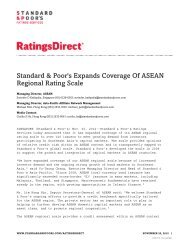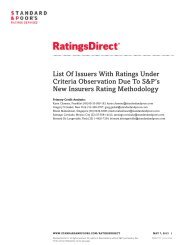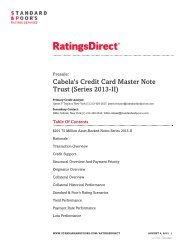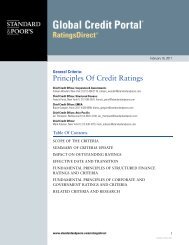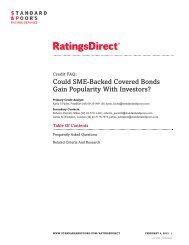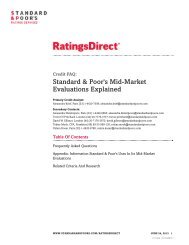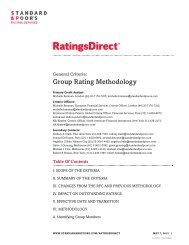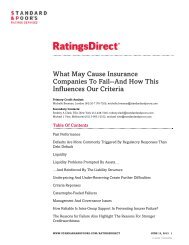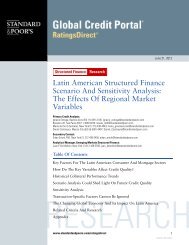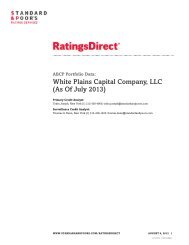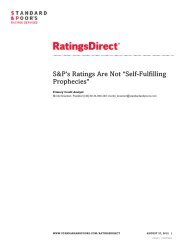Ginnie Mae, Fannie Mae, And Freddie Mac ... - Standard & Poor's
Ginnie Mae, Fannie Mae, And Freddie Mac ... - Standard & Poor's
Ginnie Mae, Fannie Mae, And Freddie Mac ... - Standard & Poor's
Create successful ePaper yourself
Turn your PDF publications into a flip-book with our unique Google optimized e-Paper software.
June 26, 2007Criteria | Governments | U.S. Public Finance:<strong>Ginnie</strong> <strong>Mae</strong>, <strong>Fannie</strong> <strong>Mae</strong>, <strong>And</strong><strong>Freddie</strong> <strong>Mac</strong> Multifamily SecuritiesPrimary Credit Analyst:Wendy Dolber, New York (1) 212-438-7994; wendy_dolber@standardandpoors.comSecondary Credit Analyst:Karen Flores, San Francisco (1) 415-371-5018; karen_flores@standardandpoors.comTable Of ContentsMBS ProgramsDirect-Pay FacilitiesStandby Credit Facilities<strong>Ginnie</strong> <strong>Mae</strong> ProgramsMBS Cash Flowswww.standardandpoors.com/ratingsdirect 1973338 | 300129047
Criteria | Governments | U.S. Public Finance:<strong>Ginnie</strong> <strong>Mae</strong>, <strong>Fannie</strong> <strong>Mae</strong>, <strong>And</strong> <strong>Freddie</strong> <strong>Mac</strong>Multifamily Securities(Editor's Note: This criteria article originally was published on June 26, 2007. We're republishing this articlefollowing our periodic review completed on Oct. 18, 2011. The following replaces criteria published on Aug. 29,2006. This article has been partially amended and superceded by Revised Methodology For Certain FederalGovernment-Enhanced Housing Transactions, published May 12, 2010.)<strong>Standard</strong> & <strong>Poor's</strong> Ratings Services rates multifamily housing transactions supported by mortgages guaranteed by<strong>Ginnie</strong> <strong>Mae</strong> and Government Sponsored Enterprises (GSEs), such as <strong>Fannie</strong> <strong>Mae</strong> and <strong>Freddie</strong> <strong>Mac</strong>. In thesestructures, <strong>Ginnie</strong> <strong>Mae</strong>, <strong>Fannie</strong> <strong>Mae</strong>, or <strong>Freddie</strong> <strong>Mac</strong> issue and deliver to the trustee an MBS in exchange for themortgage loan. Over the past few years, however, <strong>Fannie</strong> <strong>Mae</strong> and <strong>Freddie</strong> <strong>Mac</strong> have typically provided theirsupport in the form of standby and direct-pay credit facilities rather than MBS. <strong>Ginnie</strong> <strong>Mae</strong> continues to issue MBSin the form of permanent loan certificates (PLCs) or construction loan certificates (CLCs) that convert to PLCs forsubstantial rehabilitation or new construction projects. Mortgage payments on the MBS, or payments from thecredit facilities, are the principal source of credit protection for the bonds and pay debt service and all programexpenses.MBS Programs<strong>Ginnie</strong> <strong>Mae</strong>, <strong>Fannie</strong> <strong>Mae</strong>, and <strong>Freddie</strong> <strong>Mac</strong> are obligated to make payments under the certificate or credit facility tothe trustee, regardless of whether payments are actually made on the underlying mortgage loans or bonds. <strong>Ginnie</strong><strong>Mae</strong> and <strong>Fannie</strong> <strong>Mae</strong> guarantee the timely remittance of principal and interest on the MBS and credit facilities.<strong>Freddie</strong> <strong>Mac</strong> only guarantees timely payment of interest and ultimate payment of principal on MBS, with theexception of the <strong>Freddie</strong> <strong>Mac</strong> Gold program. Generally, <strong>Freddie</strong> <strong>Mac</strong> guarantees that principal on the participationcertificate will be received within approximately one year of the scheduled due dates. <strong>Standard</strong> & <strong>Poor's</strong> considerswhether this one-year lag in principal is addressed through funding of a reserve in the issue or lagging all bondmaturities by one year. Other alternatives may be discussed on a case-by-case basis.From a rating perspective, <strong>Freddie</strong> <strong>Mac</strong> and <strong>Fannie</strong> <strong>Mae</strong> programs are very similar in many respects to the <strong>Ginnie</strong><strong>Mae</strong> programs outlined below, and the criteria should be used when structuring <strong>Freddie</strong> <strong>Mac</strong> and <strong>Fannie</strong> <strong>Mae</strong>transactions. With regard to payment receipt dates, <strong>Freddie</strong> <strong>Mac</strong> MBS are assumed to be received on the 20th of themonth (the 16th if book entry form) and <strong>Fannie</strong> <strong>Mae</strong> securities on the 25th of the month. In <strong>Ginnie</strong> <strong>Mae</strong> programs,payments are assumed to be received on the 20th of the month, although <strong>Ginnie</strong> <strong>Mae</strong> pays on the 15th. <strong>Standard</strong> &<strong>Poor's</strong> generally assumes an additional five-day lag in the cash flows for <strong>Ginnie</strong> <strong>Mae</strong> MBS, because MBS paymentsare not made directly by <strong>Ginnie</strong> <strong>Mae</strong>. This is not the case for <strong>Fannie</strong> <strong>Mae</strong> and <strong>Freddie</strong> <strong>Mac</strong>, whose payments aremade directly. There is an additional 30-day payment receipt delay at the onset of all <strong>Freddie</strong> <strong>Mac</strong> programs, and<strong>Standard</strong> & <strong>Poor's</strong> considers how this is addressed in the indenture and in the cash flows. (Note: <strong>Standard</strong> & <strong>Poor's</strong>defines a lag as a delay in payment that is in addition to the normal arrearage—the time period encompassed fromthe date of origination until the first scheduled payment.)www.standardandpoors.com/ratingsdirect 2973338 | 300129047
Criteria | Governments | U.S. Public Finance: <strong>Ginnie</strong> <strong>Mae</strong>, <strong>Fannie</strong> <strong>Mae</strong>, <strong>And</strong> <strong>Freddie</strong> <strong>Mac</strong> Multifamily SecuritiesDirect-Pay Facilities<strong>Fannie</strong> <strong>Mae</strong> and <strong>Freddie</strong> <strong>Mac</strong> provide credit and liquidity support for fixed and floating-rate bonds. <strong>Fannie</strong> <strong>Mae</strong> and<strong>Freddie</strong> <strong>Mac</strong> cover for preference and stay provisions provided under the U.S. Bankruptcy code for funds paid bynon-rated sources. These floating-rate transactions usually have a seven-day variable rate, where bondholders havethe option to tender bonds upon seven days' notice. The GSEs are obligated to make payments under their respectivefacilities to the trustee in the event that the mortgage payment has not been received by a certain date. Additionally,the GSEs are obligated to cover the purchase price of tendered bonds in the event of a failed remarketing. With thisbond structure, <strong>Fannie</strong> <strong>Mae</strong> or <strong>Freddie</strong> <strong>Mac</strong> pay the bond debt service directly as if it were the mortgage loan, muchlike a direct-pay LOC. Although not an LOC, this facility is similar to a bond LOC transaction. In this instance, thetrustee draws monthly on the facility and uses the funds to pay debt service on the bonds. Cash flows areunnecessary because payments are received by the trustee prior to debt service payment dates.<strong>Fannie</strong> <strong>Mae</strong> has modified its direct-pay facility to include a bifurcation of credit and liquidity expiration dates sothat the liquidity support provided under the enhancement expires 10 years after the effective date of the agreement.This change introduces the possibility for a tender option to occur without the necessary liquidity support in placeto pay the purchase price of bonds. To avoid this structural risk, <strong>Standard</strong> & <strong>Poor's</strong> considers whether liquidityevents such as mandatory or optional tenders are scheduled to precede the termination of the liquidity portion of thedirect-pay instrument.<strong>Fannie</strong> <strong>Mae</strong> and <strong>Freddie</strong> <strong>Mac</strong> direct-pay structures may include a mandatory tender upon substitution of analternate credit facility without rating maintenance. This substitution could be problematic in the fixed-rate mode ifthe liquidity support has expired. To resolve this issue, the documents typically:• Limit substitution to the variable-rate modes;• Provide that the credit facility portion or a liquidity facility portion will be available to back the tender;• Indicate that credit facility expiration leads to a redemption; or• Indicate that substitution can only occur if remarketing proceeds equal to the full purchase price of the bonds areto be on hand for the substitution to occur, otherwise the credit facility will remain in effect or there will be aredemption of the bonds if the credit facility is scheduled to expire.These suggestions resolve <strong>Standard</strong> & <strong>Poor's</strong> liquidity concerns that could negatively affect bondholders. <strong>Standard</strong>& <strong>Poor's</strong> will continue to evaluate the direct-pay structure and legal documents to see how this issue is addressed.Standby Credit Facilities<strong>Fannie</strong> <strong>Mae</strong> and <strong>Freddie</strong> <strong>Mac</strong> provide another type of credit enhancement on bond issues in the form of a standbycredit facility. In this structure, the GSE is obligated to make payments to the trustee in the amount of the mortgagepayment once the payment is a specified number of days delinquent. Since the GSE agreement does not coverinvestment earnings, <strong>Standard</strong> & <strong>Poor's</strong> looks to see if all revenues are invested in investments rated as high as thebonds. In addition, <strong>Standard</strong> & <strong>Poor's</strong> considers whether payment of trustee fees are provided for in a no-defaultand post-default situation. Similar to the cash flows indicated for MBS as described below, standby credit facilitytransactions typically include cash flows run with a lag to take into account the timing of the GSE's payment to thetrustee, as well as the regular payment lag on the underlying project mortgage.www.standardandpoors.com/ratingsdirect 3973338 | 300129047
Criteria | Governments | U.S. Public Finance: <strong>Ginnie</strong> <strong>Mae</strong>, <strong>Fannie</strong> <strong>Mae</strong>, <strong>And</strong> <strong>Freddie</strong> <strong>Mac</strong> Multifamily Securitiesaccruing bonds. <strong>Standard</strong> & <strong>Poor's</strong> looks to the cash flows to demonstrate sufficient asset coverage during this timeframe.Concerning optional prepayments, the prepayment penalty on the mortgage needs to be seasoned 91 days to avoidrecapture as a preferential payment. <strong>Ginnie</strong> <strong>Mae</strong> may not cover the premium portion to be paid on the bonds in theevent that it would be obligated to pass through the prepayment. This seasoning problem can be eliminated throughan issue-specific letter from <strong>Ginnie</strong> <strong>Mae</strong> stating that it will guarantee the premium portion of the payment on themortgage. <strong>Standard</strong> & <strong>Poor's</strong> reviews the trust indenture to see that notice of redemption on all prepayments are notto be made until the premium is seasoned.Additionally, <strong>Standard</strong> & <strong>Poor's</strong> looks to see whether prepayment terms on the bonds match the prepayment termson the mortgage (this avoids the mortgagor making a prepayment that cannot be used immediately to call bonds)and whether redemptions resulting from prepayments provide that the resulting decrease in debt service on thebonds is proportional, as nearly as is practicable, to the decrease in the payments on the <strong>Ginnie</strong> <strong>Mae</strong> securitiesduring such period (this method ensures that even if a curtailment occurs instead of a ratable reduction of futuremortgage payments, debt service will still be met, as it will be structured around the prepaid mortgage terms).<strong>Standard</strong> & <strong>Poor's</strong> also looks to see whether the trust indenture states that the <strong>Ginnie</strong> <strong>Mae</strong> MBS is to be held by thetrustee or in the trustee's name by the Federal Reserve and that the trustee has a first perfected security interest inthe MBS.MBS Cash FlowsAs a general matter, <strong>Standard</strong> & <strong>Poor's</strong> uses worst-case assumptions when reviewing cash flows for this program.For construction financing programs, <strong>Standard</strong> & <strong>Poor's</strong> looks to see that the worst case indicates the leastfavorable time from a revenue-generating standpoint for drawing on the acquisition fund to acquire the MBS. Forexample, if the acquisition fund investment agreement earns less than the MBS, <strong>Standard</strong> & <strong>Poor's</strong> considerswhether the acquisition scenario assumes delivery on the latest possible date provided under the indenture. For eachday that the MBS is not acquired, more negative arbitrage is created. The maximum amount of this shortfall istypically covered in one of the following ways:• Providing an unsecured LOC or cash;• Selling the bonds at a premium; or• Using another ratable credit enhancement.<strong>Standard</strong> & <strong>Poor's</strong> reviews the acquisition section of the indenture and the financing agreement to see whether themethod employed is defined clearly.In addition, <strong>Standard</strong> & <strong>Poor's</strong> reviews the submitted cash flow simulations to see that they are run usingappropriate lags, have sufficient excess assets to cover for reinvestment risk, and include all fees paid from revenuesor interest income. <strong>Standard</strong> & <strong>Poor's</strong> will review financing documents to check that fees are capped or fullysubordinate to debt service. If fees are expressed as a fixed dollar amount and not as a percentage reduced over time,<strong>Standard</strong> & <strong>Poor's</strong> typically requests a 90% immediate prepayment run. This is to ensure that the fixed fees couldbe paid in the event of a large prepayment. Alternatively, the fees specified in the legal documents can be ratablyreduced with any prepayments. Expenses for MBS include <strong>Ginnie</strong> <strong>Mae</strong>, <strong>Fannie</strong> <strong>Mae</strong>, or <strong>Freddie</strong> <strong>Mac</strong> fees and lenderfees.www.standardandpoors.com/ratingsdirect 5973338 | 300129047
Copyright © 2012 by <strong>Standard</strong> & <strong>Poor's</strong> Financial Services LLC. All rights reserved.No content (including ratings, credit-related analyses and data, model, software or other application or output therefrom) or any part thereof (Content) may be modified,reverse engineered, reproduced or distributed in any form by any means, or stored in a database or retrieval system, without the prior written permission of <strong>Standard</strong> & <strong>Poor's</strong>Financial Services LLC or its affiliates (collectively, S&P). The Content shall not be used for any unlawful or unauthorized purposes. S&P and any third-party providers, as wellas their directors, officers, shareholders, employees or agents (collectively S&P Parties) do not guarantee the accuracy, completeness, timeliness or availability of theContent. S&P Parties are not responsible for any errors or omissions (negligent or otherwise), regardless of the cause, for the results obtained from the use of the Content, orfor the security or maintenance of any data input by the user. The Content is provided on an "as is" basis. S&P PARTIES DISCLAIM ANY AND ALL EXPRESS OR IMPLIEDWARRANTIES, INCLUDING, BUT NOT LIMITED TO, ANY WARRANTIES OF MERCHANTABILITY OR FITNESS FOR A PARTICULAR PURPOSE OR USE, FREEDOM FROM BUGS,SOFTWARE ERRORS OR DEFECTS, THAT THE CONTENT'S FUNCTIONING WILL BE UNINTERRUPTED, OR THAT THE CONTENT WILL OPERATE WITH ANY SOFTWARE ORHARDWARE CONFIGURATION. In no event shall S&P Parties be liable to any party for any direct, indirect, incidental, exemplary, compensatory, punitive, special orconsequential damages, costs, expenses, legal fees, or losses (including, without limitation, lost income or lost profits and opportunity costs or losses caused by negligence)in connection with any use of the Content even if advised of the possibility of such damages.Credit-related and other analyses, including ratings, and statements in the Content are statements of opinion as of the date they are expressed and not statements of fact.S&P's opinions, analyses, and rating acknowledgment decisions (described below) are not recommendations to purchase, hold, or sell any securities or to make anyinvestment decisions, and do not address the suitability of any security. S&P assumes no obligation to update the Content following publication in any form or format. TheContent should not be relied on and is not a substitute for the skill, judgment and experience of the user, its management, employees, advisors and/or clients when makinginvestment and other business decisions. S&P does not act as a fiduciary or an investment advisor except where registered as such. While S&P has obtained information fromsources it believes to be reliable, S&P does not perform an audit and undertakes no duty of due diligence or independent verification of any information it receives.To the extent that regulatory authorities allow a rating agency to acknowledge in one jurisdiction a rating issued in another jurisdiction for certain regulatory purposes, S&Preserves the right to assign, withdraw, or suspend such acknowledgement at any time and in its sole discretion. S&P Parties disclaim any duty whatsoever arising out of theassignment, withdrawal, or suspension of an acknowledgment as well as any liability for any damage alleged to have been suffered on account thereof.S&P keeps certain activities of its business units separate from each other in order to preserve the independence and objectivity of their respective activities. As a result,certain business units of S&P may have information that is not available to other S&P business units. S&P has established policies and procedures to maintain theconfidentiality of certain nonpublic information received in connection with each analytical process.S&P may receive compensation for its ratings and certain analyses, normally from issuers or underwriters of securities or from obligors. S&P reserves the right to disseminateits opinions and analyses. S&P's public ratings and analyses are made available on its Web sites, www.standardandpoors.com (free of charge), and www.ratingsdirect.comand www.globalcreditportal.com (subscription), and may be distributed through other means, including via S&P publications and third-party redistributors. Additionalinformation about our ratings fees is available at www.standardandpoors.com/usratingsfees.www.standardandpoors.com/ratingsdirect 7973338 | 300129047




